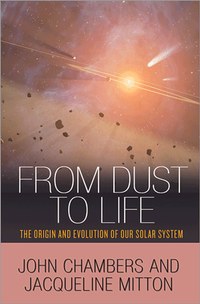Review: From Dust to Lifeby Jeff Foust
|
| One key takeaway from this book is that planet formation was a lot more dynamic than the simplistic models taught even in the relatively recent past. |
The current state of those studies is ably explained in From Dust to Life, a book by planetary scientist John Chambers and science writer Jacqueline Mitton. The duo examine the history and current state of knowledge of the formation of our solar system, stretching from astrophysics (the formation of our Sun and the age of the universe) to astrobiology (the formation of life on Earth.) The bulk of the book, though, looks at the formation of the planets, moons, and small bodies in the solar system, and how the solar system achieved its present form.
One key takeaway from this book is that planet formation was a lot more dynamic than the simplistic models taught even in the relatively recent past. In particular, scientists now believe that planets migrated through the solar system during its formation, something illustrated by the discovery of other solar systems that have, for example, Jupiter-sized worlds closely orbiting stars. In our solar system, the “Grand Tack” model has Jupiter migrating closer to the Sun, approaching 1.5 astronomical units (AU) from the Sun before the presence of Saturn caused Jupiter to reverse direction back out to its current location at 5.2 AU. That inward and outward migration could explain the relatively small size of Mars and also clear out most of the material in the main asteroid belt.
Another model, called the “Nice model” for the French city where it was developed, predicts the four outer planets formed relatively closely together. Complex gravitational interactions among them and icy planetesimals, caused them to evolve into the current orbits while, at one point, scattering many of those planetesimals into the inner solar system. That created the “late heavy bombardment” that scarred the surfaces of Mercury, Mars, and the Moon with craters we see today, while likely resetting the formation of life on Earth.
Chambers and Mitton stay focused on the science in From Dust to Life: unlike other books that create narratives around the scientists, they discuss the science and the history of its development, rather than the individuals who made it possible. That’s a worthwhile trade: while there have been, and are today, interesting people studying the formation of the solar system, the science is even more fascinating as we find out just how complex the process is to turn a cloud of gas and dust into a star and planets. As we make new discoveries about our own solar system, as well as more discoveries of other solar systems, that science becoming far more complex, but also no less fascinating.
